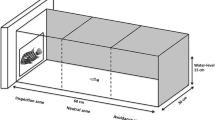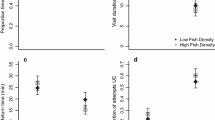Summary
Predatory threat can vary during a predator-prey interaction as an attack escalates or among predators at different times. A Threat-sensitivity hypothesis is presented which predicts that prey individuals will trade-off predator avoidance against other activities by altering their avoidance responses in a manner that reflects the magnitude of the predatory threat. This hypothesis was tested in the field by presenting prey (threespot damselfish, Stegastes planifrons) with models of foraging predators (Atlantic trumpetfish, Aulostomus maculatus). During a presentation, damselfish displayed progressively stronger avoidance as predator models were brought nearer; response waned rapidly once predator models passed overhead. Larger predator models and those oriented in a strike pose evoked stronger avoidance reactions than smaller and non-attacking models, intermediate responses were evoked by size and orientation combinations that were intermediate in threat, and habituation was more common to weakly-threatening presentations. Smaller damselfish showed stronger avoidance of models than did larger damselfish. Nonavoidance activities, such as feeding and territorial defense, were curtailed during presentations or were more common during weakly threatening presentations. Approaches to the models, equated with mobbing, were more common among large damselfish, again reflecting degrees of vulnerability among different size prey individuals. These initial results indicate that damselfish threatened by predators respond in a graded manner that reflects the degree of threat posed by the predator, in accordance with the Threat-sensitivity hypothesis.
Similar content being viewed by others
References
Aronson RB (1983) Foraging behavior of the west Atlantic trumpetfish, Aulostomus maculatus: use of large, herbivorous reef fishes as camouflage. Bull Mar Sci 33:166–171
Caraco T, Martindale S, Whittam TS (1980) An empirical demonstration of risk-sensitive foraging preferences. Anim Behav 28:820–830
Cerri RD, Fraser DF (1983) Predation and risk in foraging minnows: balancing conflicting demands. Am Nat 121:552–561
Conover WJ (1980) Practical nonparametric statistics, 2nd edn. Wiley, New York
Curio E (1976) The ethology of predation. Springer, Berlin Heidelberg New York
Curio E (1978) The adaptive significance of avian mobbing. I. Teleonomic hypotheses and predictions. Z Tierpsychol 48:175–183
Davies NB, Houston AI (1984) Territory economics. In: Krebs JR, Davies NB (eds) Behavioural ecology, 2nd edn. Sinauer Sunderland, pp 148–169
Dill LM (1987) Animal decision making and its ecological consequences: the future of aquatic ecology and behaviour. Can J Zool 65:803–811
Dill LM, Fraser AHG (1984) Risk of predation and the feeding behavior of juvenile coho salmon (Oncorhynchus kisutch). Behav Ecol Sociobiol 16:65–71
Donaldson TJ (1984) Mobbing behavior by Stegastes albifasciatus (Pomacentridae), a territorial mosaic damselfish. Japan J Ichthyol 31:345–348
Ebersole JP (1977) The adaptive significance of interspecific territoriality in the reef fish Eupomacentrus leucostictus. Ecology 58:914–920
Edmunds M (1974) Defence in animals. Longman, Essex
Eibl-Eibesfeldt I (1955) Über Symbiosen, Parasitismus und andere besondere zwischenartliche Beziehungen tropischer Meeresfische. Z Tierpsychol 12:203–219
FitzGerald GJ, van Havre N (1985) Flight, fright and shoaling in sticklebacks (Gasterosteidae). Biol Behav 10:321–331
Fraser DF, Huntingford FA (1986) Feeding and avoiding predation hazard: the behavioral response of the prey. Ethology 73:56–68
Gilliam JF, Fraser DF (1987) Habitat selection under predation hazard: test of a model with foraging minnows. Ecology 68:1856–1862
Godin J-GJ, Smith SA (1988) A fitness cost of foraging in the guppy. Nature (London) 333:69–71
Harvey C, Garneau F-X, Himmelman JH (1987) Chemodetection of the predatory seastar Leptasterias polaris by the whelk Buccinum undatum. Mar Ecol Prog Ser 40:79–86
Helfman GS (1983) Resin-coated fishes: a simple model technique for in situ studies of fish behavior. Copeia 1986:547–549
Helfman GS (1986) Behavioral responses of prey fishes during predator-prey interactions. In: Feder ME, Lauder GV (eds) Predator-prey relationships. University Chicago Press, Chicago, pp 135–156
Helfman GS, Clark JB (1986) Rotational feeding: overcoming gape-limited foraging in anguillid eels. Copeia 1986:679–685
Holbrook SJ, Schmitt RJ (1988) Effects of predation risk on foraging behavior: mechanisms altering patch choice. J Exp Mar Biol Ecol 121:151–163
Ishihara M (1987) Effect of mobbing toward predators by the damselfish Pomacentrus coelestis (Pisces: Pomacentridae). J Ethol 5:43–52
Jaeger RG, Nishikawa KCB, Barnard DE (1983) Foraging tactics of a terrestrial salamander: costs of territorial defence. Anim Behav 31:191–198
Karplus I, Goren M, Algom D (1982) A preliminary experimental analysis of predator face recognition by Chromis caeruleus (Pisces, Pomacentridae). Z Tierpsychol 58:53–65
Kaufman L (1976) Feeding behavior and functional coloration of the Atlantic trumpetfish, Aulostomus maculatus. Copeia 1976:377–378
Krebs JR, Dawkins R (1984) Animal signals: mind-reading and manipulation. In: Krebs JR, Davies NB (eds) Behavioural ecology and evolutionary approach, 2nd edn. Sinauer, Sunderland, pp 380–402
Lima SL, Valone TJ, Caraco T (1985) Foraging-efficiency-predation-risk trade-off in the grey squirrel. Anim Behav 33:155–165
Lucas JR (1987) Foraging time contraints and diet choice. In: Kamil AC, Krebs JR, Pulliam HR (eds) Foraging behavior. Plenum Press, New York, pp 239–269
Magurran AE (1986) Predator inspection behaviour in minnow shoals: differences between populations and individuals. Behav Ecol Sociobiol 19:267–273
Magurran AE, Girling SL (1986) Predator model recognition and response habituation in shoaling minnows. Anim Behav 34:510–518
Magurran AE, Pitcher TJ (1987) Provenance, shoal size and the sociobiology of predator-evasion behavior in minnow shoals. Proc R Soc London B 229:439–465
Martindale S (1982) Nest defense and central place foraging: a model and experiment. Behav Ecol Sociobiol 10:85–89
Milinski, M (1986) Constraints placed by predators on feeding behavior. In: Pitcher TJ (ed) The behaviour of teleost fishes. Croom Helm, London, pp 236–252
Milinski M, Heller R (1978) Influence of a predator on the optimal foraging behaviour of sticklebacks (Gasterosteus aculeatus L.). Nature (London) 275:642–644
Pitcher TJ, Green D, Magurran AE (1986) Dicing with death: predator inspection behaviour in minnow shoals. J Fish Biol 28:439–448
Power ME (1987) Predator avoidance by grazing fishes in temperate and tropical streams: importance of stream depth and prey size. In: Kerfoot WC, Sih A (eds) Predation direct and indirect impacts on aquatic communities. University Press New England, Hanover, pp 333–351
Randall JE (1967) Food habits of reef fishes of the West Indies. Stud Trop Oceanogr Miami 5:665–847
Robertson DR, Sweatman HPA, Fletcher EA, Cleland MG (1976) Schooling as a mechanism for circumventing the territoriality of competitors. Ecology 57:1208–1220
Robertson DR, Hoffman SG, Sheldon JM (1981) Availability of space for the territorial Caribbean damselfish Eupomacentrus planifrons. Ecology 62:1162–1170
Sih A (1980) Optimal behavior: can foragers balance two conflicting demands? Science 210:1041–1043
Sih A (1982) Foraging strategies and the avoidance of predation by an aquatic insect, Notonecta hoffmanni. Ecology 63:786–796
Sih A (1987) Predators and prey lifestyles: an evolutionary and ecological overview. In: Kerfoot WC, Sih A (eds) Predation direct and indirect impacts on aquatic communities. University Press New England, Hanover, pp 203–224
Stein RA, Magnuson JJ (1976) Behavioral response of crayfish to a fish predator. Ecology 57:751–761
Thresher RE (1976) Field analysis of the territoriality of the threespot damselfish, Eupomacentrus planifrons (Pomacentridae). Copeia 1976:266–276
Werner EE, Gilliam JF (1984) The ontogenetic niche and species interactions in size-structured populations. Ann Rev Ecol Syst 15:393–425
Werner EE, Gilliam JF, Hall DJ, Mittelbach GG (1983) An experimental test of the effect of predation risk on habitat use in fish. Ecology 64:1540–1548
Williams AH (1980) The threespot damselfish: a noncarnivorous keystone species. Am Nat 116:138–142
Woodland DJ, Jaafar Z, Knight M-L (1980) The “pursuit deterrent” function of alarm signals. Am Nat 115:748–753
Ydenberg RC, Dill LM (1986) The economics of fleeing from predators. Adv Stud Behav 16:229–249
Zar JHG (1974) Biostatistical analysis. Prentice Hall, Englewood Cliffs
Zaret TM, Suffern JS (1976) Vertical migration in zooplankton as a predator avoidance mechanism. Limnol Oceanogr 21:804–813
Author information
Authors and Affiliations
Rights and permissions
About this article
Cite this article
Helfman, G.S. Threat-sensitive predator avoidance in damselfish-trumpetfish interactions. Behav Ecol Sociobiol 24, 47–58 (1989). https://doi.org/10.1007/BF00300117
Received:
Accepted:
Issue Date:
DOI: https://doi.org/10.1007/BF00300117




